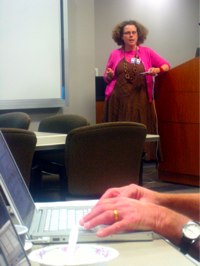Live blogged -- please excuse typos and awkward wording.
 I’m back at CTAP 3 for their Coordinating Council Meeting, with various presentation during the morning.
I’m back at CTAP 3 for their Coordinating Council Meeting, with various presentation during the morning.
Kathleen Ferenz, of California Region IV, is presenting about a media archive projected called HistoryCaliSphere. She’s doing the presentation from an iPod Touch.
Kathleen makes the point that this is not just a clip art archive. What they seek to do is to use the images as part of a connecting narrative of the state’s history. It provides some fairly deep background information on the images and topics.
The team is holding some professional development events for the project, and are deliberately presenting the project with iPod touch, to model the idea that we can bring digital networked information into our classrooms without a full computer and ceiling-mounted projector — Not that this is an excuse for not having a computer and ceiling-mounted projector in every classroom 😉
Kathleen is now showing an Animoto video of one of their events. It occurs to me that students might enjoy selecting Calisphere images, anotate them into some sort of specialized history text. Then they could upload it to one of the self-publishing services (Lulu), and publish their own book.
 Alan Phillips, of California’s K-12 High Speed Network, is presenting edZone, a palette of web tools for educators. The site is set up for federated searching, so that a queries access resources from all aspects of the site. It includes a My edZone page, where you can establish a profile page, set up multiple blogs, and other customizing features. The interface is very simple and clearly laid out.
Alan Phillips, of California’s K-12 High Speed Network, is presenting edZone, a palette of web tools for educators. The site is set up for federated searching, so that a queries access resources from all aspects of the site. It includes a My edZone page, where you can establish a profile page, set up multiple blogs, and other customizing features. The interface is very simple and clearly laid out.
Resources (say blog posts) can be made available to the public, other edZone users (trusted community), to groups, or private. Someone asked about who’s monitoring the content. They are using a community approach, each piece of content is accompanied by a “Flag as inappropriate” linked, which can be clicked by anyone who judges the information needing consideration.
Other working features are videos, groups, podcasts, and docments. In development are:
- Social Networking,
- Wikis,
- Messaging,
- Moodle,
Users can create albums of content, which can be images-only (for instance) or mixed media. Other users can subscribe to the RSS feeds to receive the content from the albums.
Time for lunch now. then… “It’s Showtime!” 🙂

Thanks for making the trip out to Sacramento to present to us. I enjoyed the resources that you shared and the vision you shared about today’s students. I hope that my blog post about your presentation is coherent. You can read it at http://burtsblog.edu580.us
David: Your post says she’s “doing the presentation from an iPod Touch.” The iPod Touch can be connected to a projector?
I think the fact that the California Department of Education is funding a project through the K12 High Speed Network that is basically a social network that includes blogs, wikis, media sharing, and more. It says something about the changing outlook on these types of social tools. I’ve been promoting these tools in my district. They are well received, especially because they are “sanctioned”. I feel this may be a breakthrough in how educators in our state begin to use these tools.